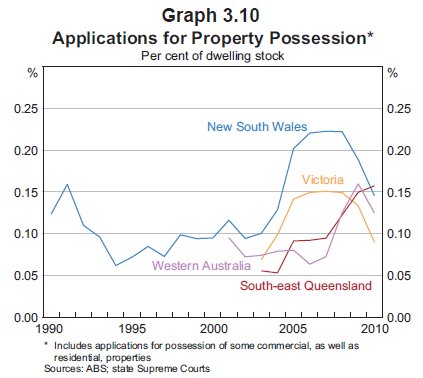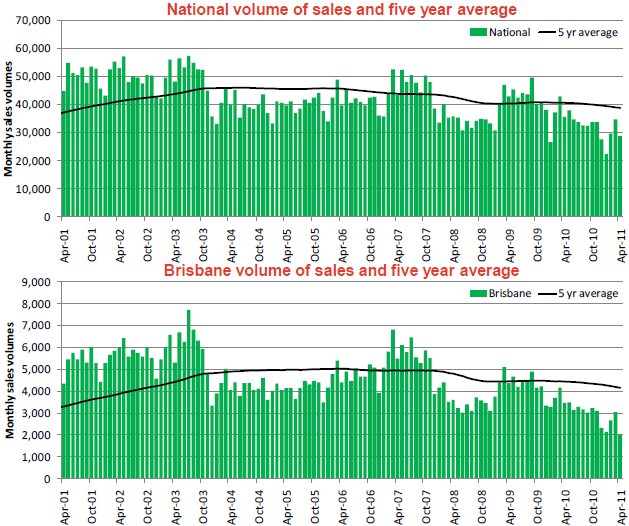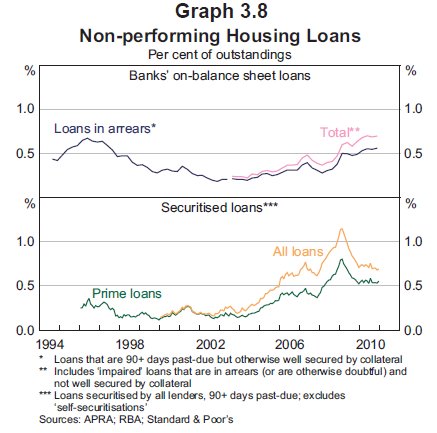In the last Financial Stability Review, the RBA had this to say about the rate of housing repossessions in Australia:
Rates of mortgagees’ applications for property possession generally declined in the second half of 2010; for the year as a whole, these rates were below those seen in recent years. The exception was south-east Queensland (comparable data are not available for the entire state), where the rate of mortgagees’ applications for property possession has continued to increase over the past few years. The nationwide rate of bankruptcies and other personal administrations declined further in the second half of 2010, and is now well below the peak in 2009. The relatively benign picture painted by these aggregate indicators of financial stress is consistent with household surveys, which show that only a small proportion of borrowers are highly geared.
The RBA’s benign view of the risks associated with the housing market is something we have discussed quite a bit at MacroBusiness and it is why I hold the view that until we see some significant changes in the broad data, the RBA is likely to ignore those crowing for immediate interest rate cuts. Quite simply their backwards looking macro data doesn’t support the premise that the housing market is about to implode or that the banks are about to be loaded up with massive amounts of bad debt.
I agree that vested interests are overstating the issue, but I hold a slightly more pessimistic view than the one held by the RBA. In all of the publication and speeches from the RBA that I have read I sense they are ignoring the “self-feeding” nature of credit driven rises and falls. This is something I have discussed previously here and here. My main areas of concern around this issue are summarised in the following two paragraphs:
The issue I had with that analysis was that the RBA seemed to be saying that the cohort who took on “riskier loans” will not get into trouble because house prices will continue to rise. This may end up being the case in the long run, but what the RBA doesn’t seem to be taking into account is the “cause and effect” in their analysis. The reason house prices continued to rise was because of the demand of the first home buyers who took on those risky loans, that is, the risk mitigator mentioned by the RBA is intrinsically linked to the cause of that same risk.
…
And that is the issue I have with this analysis. There is no way banks were going to see large increases in defaults in a rising market, anyone in financial trouble has been able to sell their property for a higher price, pay down their debt and move on with their lives. Even those who have recently been in financial trouble have been able to access hardship assistance which would have given them time to sell their house if need be. It is when the market begins to fall that the potential for trouble begins. A falling housing market has the potential to have large flow-on effects to the rest of the economy, some of which I believe we have already seen across South East Queensland. I may be misinterpreting their views here, but after reading the FSR I once again came away with the feeling that the RBA analysts don’t appreciate that point.
Last time we saw rising delinquencies the RBA/government solution was to re-stimulate the housing market. This solved the short-term issue but is also meant that Australian household indebtedness continued to rise which in my opinion added further instability to the economy and has the potential to make the long term issue worse.
Obviously the numbers of properties in possession is still very low and it may be the case that my view goes down in history as overly pessimistic. But despite a high rate of population growth in Australia over recent years national real estate sale volumes are now at GFC levels and still trending downwards, with some areas now at levels not seen since the 90s. If this continues to be the case then it would seem to me that the “sell if you get into trouble” plan is also on shaky ground.
With this at the back of my mind I find any evidence of a new uptick in mortgage delinquencies more worrying than usual because the “get out of jail free card” doesn’t exist when credit driven asset values are not rising. Over the weekend the Herald Sun reported that we are seeing a new upward trend in Victoria:
More than 400 repossession writs have been served on home buyers in the past two months. They are the highest figures for almost two years, more than double the number of repossession writs filed in the Supreme Court of Victoria six months ago.
Lenders lodged 206 writs in the Supreme Court last month against people who had defaulted on their mortgage repayments. It was slightly less than May’s figure of 221 writs. The last time figures were so high was in July 2009, when 231 repossession writs were filed. In December there were just 89 and in January 90.
The writs are the first step in the repossession process, though many home owners come to an agreement with their bank. Between July 2007 and June 2009 the number of monthly repossession writs filed in the Supreme Court dipped below 200 only twice.
As I have said a few times in recent months, the real estate market now feels as it did in 2008. You can see from this article that was published at the time that delinquencies feed into the falling cycle (my emphasis):
It’s every home owner’s heartbreak – watching the value of their home plummet to half the price they paid within a few years. And in working-class suburbs around the country, it’s becoming an all-too-regular occurrence.
Zaia Dawood, a real estate agent at Fairfield in Sydney’s southwest, last week sold a two-bedroom unit – bought for $240,000 in 2006 – for just $140,000.
“It is a massive decrease, but it’s not rare in these areas,” Mr Dawood said at the weekend.
“A property that was worth $400,000 last year is unlikely to sell for more than $300,000 this year.
“The housing market all over Sydney is slowing down, but in southwestern Sydney it’s the worst.”
Mr Dawood said the high level of repossessions because of failure to pay mortgages was the major reason for the rapid price decline.
I am unable to find any more recent data for most of the states as their supreme courts do not make their data directly publicly available. The only state data I can find is Western Australia, and in that case the data clearly shows the same trend:
There was also a report in the SMH over the weekend that ANZ has had to add additional staff to deal with loan re-payment issues:
ANZ bank will add as many as 100 people to its office in the Philippines to handle increased work calling customers in Australia that have fallen behind in making loan repayments. The new positions add to about 1,000 of ANZ Bank’s Manila-based staff, and are in addition to the 800 working in Australia on its collections team, according to an e-mailed statement.
Again, as the FSR shows these numbers are still low and this may end up being needless worry on my part:
But with low and falling home sales, a central bank with an inflation fighting upwards bias, a government with a political slant toward surplus and consumer confidence tumbling, I once again have to question the behaviour of the banks with their bad debt provisioning. I understand that there is shared responsibility in the mortgage delinquency issue (something I have discussed previously) and the banks certainly do not deserve all of the blame. But Australian bank chiefs are on record downplaying risks in order to support their own profitability. These statements along with their recent balance-sheet behaviour suggests to me that they maybe willing to forgo economic stability for the sake of their equity holders. If that is the case then it is something we should all be concerned about.



